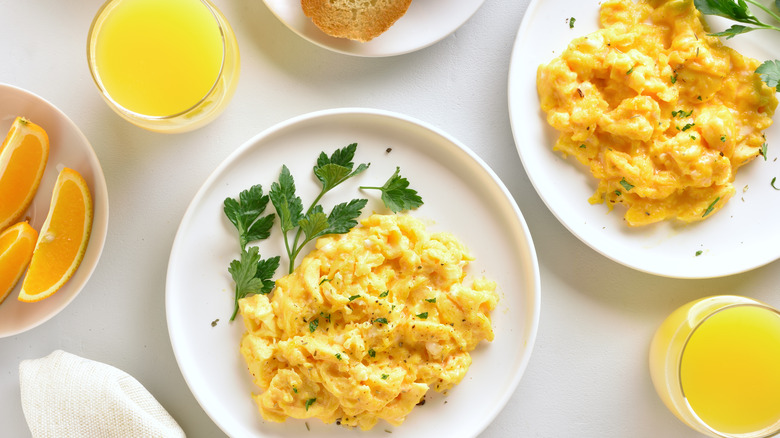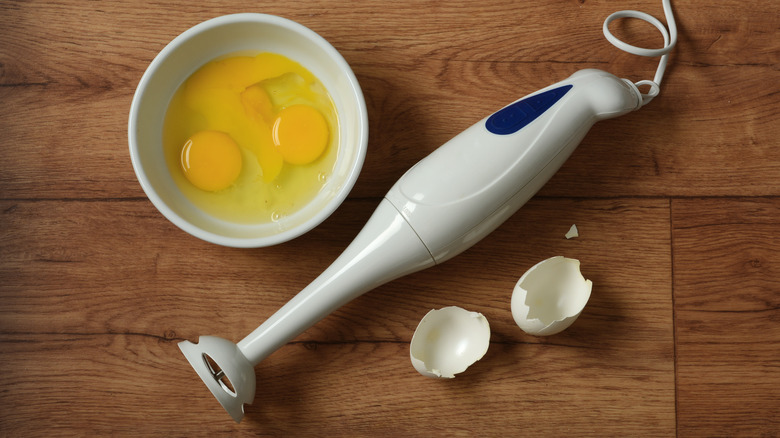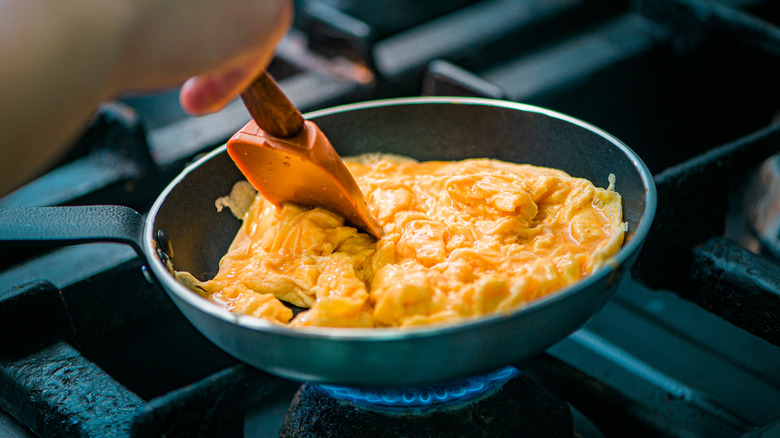The Blender Trick For Scrambled Eggs So Fluffy They Make Clouds Jealous
For a dish that seems incredibly simple, there are countless techniques for making perfect scrambled eggs, and individual preferences complicate matters even further. There's debates around whether to start with a hot or cold pan, whether to add milk; cream, butter, or even lemon juice; and how to best prepare the eggs before they even touch the pan. Many cooks prefer to whisk their eggs to make them result lighter and fluffier, but to take that fluffiness to the next level, it's worth going one step further and actually blending them.
When you beat eggs vigorously for, say, a cake recipe, the process fills them with air to create a light, billowy texture as they grow in size. It's easy to see how this trick works for fluffier scrambled eggs, too. That airy texture remains even after the eggs are cooked, making the finished scramble unbelievably fluffy, and a blender aerates the eggs even more effectively than a stand mixer (or a whisk, for that matter).
There's another advantage to the blender method, too: It makes it much quicker (and easier) to prepare a large quantity of eggs. So if you're cooking for a crowd, but don't want to spend a huge amount of time and energy whisking by hand, try the blender for the best eggs without the arm ache.
How adding air makes for a light and fluffy scramble
When it comes to making restaurant-quality scrambled eggs at home, using a fork or whisk to whip the eggs is a reliable technique. You could even shake eggs in a mason jar to make them fluffier, but a blender winds hands-down in terms of effectiveness and speed. When you whip the eggs rapidly using the quick blades, the whites' proteins allow them to expand and become foam-like, a process you can also see when whipping them to make meringues.
Ovalbumin and ovomucin are two proteins within the whites that increase in volume when beaten, and can expand to an impressive six to eight times their original size. Ovalbumin creates the foamy texture , and ovomucin retains those air bubbles once the eggs are heated. This ensures that the "curds" in your eggs become large and fluffy when cooked, resulting in a scramble that's light rather than dense or rubbery.
As for what type of blender to use, either an immersion blender or a stand blender can work equally well. Try blending the eggs three to five seconds on a low setting to start with. They'll be ready to cook once the whites and yolks are combined.
A blender produces creamier eggs that cook evenly
A blender also works to properly combine egg yolks and whites, which is a must-do in any scrambled egg recipe. Because of their different protein structures, yolks and whites actually cook at different speeds. The white, which contains more water, coagulates (or becomes solid) at around 144 to 149 degrees Fahrenheit, whereas the fattier yolk cooks more slowly, coagulating at 149 to 158 degrees Fahrenheit.
Blending mixes the whites and yolks seamlessly to create a uniform texture, so the whole mixture will cook at the same rate, without the separate streaks of white and yellow that may result from whisking by hand. The result is a much creamier scramble, as well as a fluffier texture. In fact, you won't need to add any milk, cream, or half-and-half to blended scrambled eggs to prevent dryness, though you could always use a little butter for a richer finish.
The blender technique is even endorsed by top chefs, such as Thomas Keller, who blends creamy French-style scrambled eggs before cooking them slowly over a low heat to make them extra-smooth. You could even pass the mixed eggs through a chinois or cheesecloth for a truly silky experience. Either way, breaking out the blender is worth it for fluffy, cloud-like eggs with a perfectly creamy taste.



